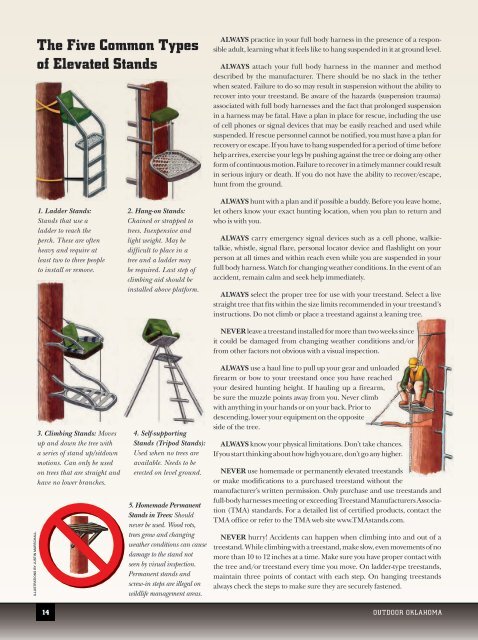Youth Deer Gun Season - Oklahoma Department of Wildlife ...
Youth Deer Gun Season - Oklahoma Department of Wildlife ...
Youth Deer Gun Season - Oklahoma Department of Wildlife ...
You also want an ePaper? Increase the reach of your titles
YUMPU automatically turns print PDFs into web optimized ePapers that Google loves.
ILLUSTRATIONS BY JUSTIN MARSCHALL The<br />
Five Common Types<br />
<strong>of</strong> Elevated Stands<br />
1. Ladder Stands:<br />
Stands that use a<br />
ladder to reach the<br />
perch. These are <strong>of</strong>ten<br />
heavy and require at<br />
least two to three people<br />
to install or remove.<br />
3. Climbing Stands: Moves<br />
up and down the tree with<br />
a series <strong>of</strong> stand up/sitdown<br />
motions. Can only be used<br />
on trees that are straight and<br />
have no lower branches.<br />
14<br />
2. Hang-on Stands:<br />
Chained or strapped to<br />
trees. Inexpensive and<br />
light weight. May be<br />
difficult to place in a<br />
tree and a ladder may<br />
be required. Last step <strong>of</strong><br />
climbing aid should be<br />
installed above platform.<br />
4. Self-supporting<br />
Stands (Tripod Stands):<br />
Used when no trees are<br />
available. Needs to be<br />
erected on level ground.<br />
5. Homemade Permanent<br />
Stands in Trees: Should<br />
never be used. Wood rots,<br />
trees grow and changing<br />
weather conditions can cause<br />
damage to the stand not<br />
seen by visual inspection.<br />
Permanent stands and<br />
screw-in steps are illegal on<br />
wildlife management areas.<br />
ALWAYS practice in your full body harness in the presence <strong>of</strong> a responsible<br />
adult, learning what it feels like to hang suspended in it at ground level.<br />
ALWAYS attach your full body harness in the manner and method<br />
described by the manufacturer. There should be no slack in the tether<br />
when seated. Failure to do so may result in suspension without the ability to<br />
recover into your treestand. Be aware <strong>of</strong> the hazards (suspension trauma)<br />
associated with full body harnesses and the fact that prolonged suspension<br />
in a harness may be fatal. Have a plan in place for rescue, including the use<br />
<strong>of</strong> cell phones or signal devices that may be easily reached and used while<br />
suspended. If rescue personnel cannot be notified, you must have a plan for<br />
recovery or escape. If you have to hang suspended for a period <strong>of</strong> time before<br />
help arrives, exercise your legs by pushing against the tree or doing any other<br />
form <strong>of</strong> continuous motion. Failure to recover in a timely manner could result<br />
in serious injury or death. If you do not have the ability to recover/escape,<br />
hunt from the ground.<br />
ALWAYS hunt with a plan and if possible a buddy. Before you leave home,<br />
let others know your exact hunting location, when you plan to return and<br />
who is with you.<br />
ALWAYS carry emergency signal devices such as a cell phone, walkietalkie,<br />
whistle, signal flare, personal locator device and flashlight on your<br />
person at all times and within reach even while you are suspended in your<br />
full body harness. Watch for changing weather conditions. In the event <strong>of</strong> an<br />
accident, remain calm and seek help immediately.<br />
ALWAYS select the proper tree for use with your treestand. Select a live<br />
straight tree that fits within the size limits recommended in your treestand’s<br />
instructions. Do not climb or place a treestand against a leaning tree.<br />
NEVER leave a treestand installed for more than two weeks since<br />
it could be damaged from changing weather conditions and/or<br />
from other factors not obvious with a visual inspection.<br />
ALWAYS use a haul line to pull up your gear and unloaded<br />
firearm or bow to your treestand once you have reached<br />
your desired hunting height. If hauling up a firearm,<br />
be sure the muzzle points away from you. Never climb<br />
with anything in your hands or on your back. Prior to<br />
descending, lower your equipment on the opposite<br />
side <strong>of</strong> the tree.<br />
ALWAYS know your physical limitations. Don’t take chances.<br />
If you start thinking about how high you are, don’t go any higher.<br />
NEVER use homemade or permanently elevated treestands<br />
or make modifications to a purchased treestand without the<br />
manufacturer’s written permission. Only purchase and use treestands and<br />
full-body harnesses meeting or exceeding Treestand Manufacturers Association<br />
(TMA) standards. For a detailed list <strong>of</strong> certified products, contact the<br />
TMA <strong>of</strong>fice or refer to the TMA web site www.TMAstands.com.<br />
NEVER hurry! Accidents can happen when climbing into and out <strong>of</strong> a<br />
treestand. While climbing with a treestand, make slow, even movements <strong>of</strong> no<br />
more than 10 to 12 inches at a time. Make sure you have proper contact with<br />
the tree and/or treestand every time you move. On ladder-type treestands,<br />
maintain three points <strong>of</strong> contact with each step. On hanging treestands<br />
always check the steps to make sure they are securely fastened.<br />
OUTDOOR OKLAHOMA







